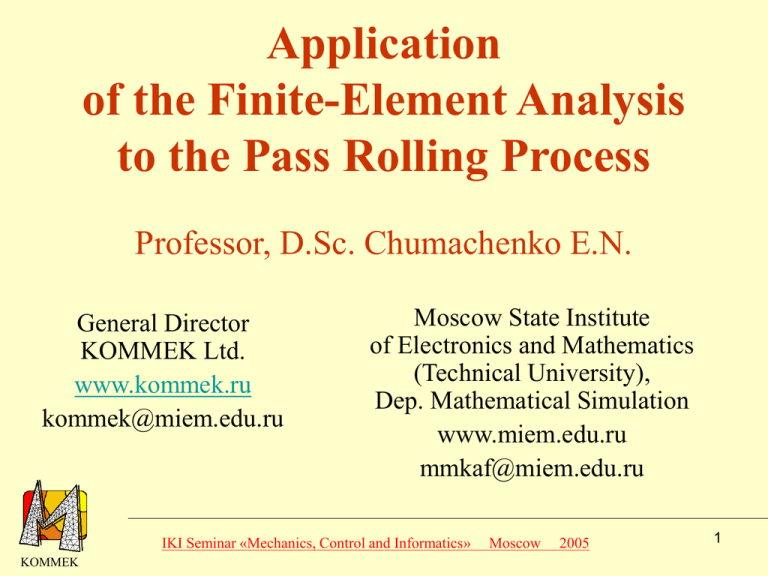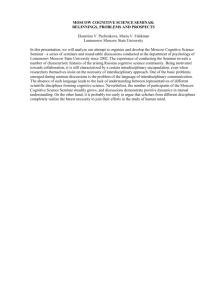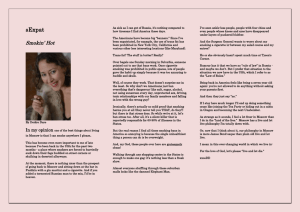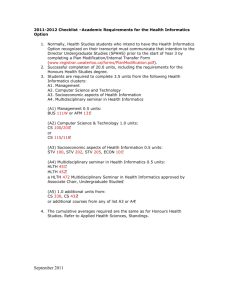Application of the Finite-Element Analysis to the Pass Rolling Process
advertisement

Application
of the Finite-Element Analysis
to the Pass Rolling Process
Professor, D.Sc. Chumachenko E.N.
General Director
KOMMEK Ltd.
www.kommek.ru
kommek@miem.edu.ru
Moscow State Institute
of Electronics and Mathematics
(Technical University),
Dep. Mathematical Simulation
www.miem.edu.ru
mmkaf@miem.edu.ru
IKI Seminar «Mechanics, Control and Informatics»
KOMMEK
Moscow
2005
1
Introduction
The basic ratios and results of pass rolling process simulation using the SPLEN
computing system developed based on the finite-element method (FEM) are
discussed.
The computing system allows setting any configuration of a roll profile, and
presently it is used for studying isothermal and non-isothermal rolling processes
with two symmetric rolls. In this model a rigid-ductile statement of the problem
and special system of friction implementation are used.
The computer system simulating the process of metal deformation in passes
allows avoiding labor-consuming and expensive industrial experiments and
reduces the time of developing technological solutions. Besides, at the design
stage already, one can reveal defects of the rolled product form and working
degree of the metal and thereby maximally approach a technological draft to the
working one.
To increase a solution algorithm speed, the half-analytical finite-elements
method was used.
IKI Seminar «Mechanics, Control and Informatics»
KOMMEK
Moscow
2005
2
Mathematical model of form changing hot materials
Boundary conditions
ij l ni j Pni i
V Vi i j j
1.25 P
, L 0.58 f e [1 exp
e
V Vroll
u i V Vroll
( V Vroll ) n 0 , L
on the
on the v (1)
] on the
v
V - velocity of particles of continuum; Vroll - mill roller speed;
P - normal pressure;
l ni - directional cosines;
- tangent stress;
n - normal to mill roller;
L - constant of friction.
i - orthonormal frames;
1
1
1
~
~
(2)
ij ij ij ;
ij ij ; ij ij ij ; ij ij ;
3
3
3
3
2
~
~ ~
~ 2 ~ 3
~
~
~
(3)
e ;
ij ij
e ; ij ij
ij
ij
e
e
2
3
Then
ij ij
2 e
ij ij
3 e
and condition entry ij , j 0 .
IKI Seminar «Mechanics, Control and Informatics»
KOMMEK
Moscow
2005
(4)
3
Heat exchange
The heat exchange of the strip with rolls and with environment is described by the following
variational equation :
[ (
S
T T T T
T
) (c T Q pl )T] rdS
r r
z z
t
(5)
{ [(T 273) 4 (Troll 273) 4 ] air (T Tair )}T rdL [ roll T Troll q fr ] T r dL 0
L air
where
S Lroll Lair
c,
q fr 0.5 V Vroll L
L roll
Qpl k pl u u
- is heat conductance coefficient;
- is thermal capacity and density of the strip material;
- is a generalized parameter dependent on the temperature difference of the
strip and environment, Stephen-Boltsman constant, blackness coefficient of the body and on
relative position of the surfaces when radiating;
roll , air - is linear expansion coefficient for environment and rolls;;
V Vroll - is relative speed module of the movement with friction;
k pl - is a coefficient taking into account the part of released heat energy.
IKI Seminar «Mechanics, Control and Informatics»
KOMMEK
Moscow
2005
4
For an arbitrary element of the strain focal point z of a little enough thickness, the value
z characterizing relative elongation speed of the fibers in an element of the thickness dz, is
constant: z ~ C . In this case constant C in each section z ~z has its own value.
z z
Speed components of particles movement in any fixed element z relative to the rolls
surfaces look like:
v x v x (x, y);
v y v y (x, y);
v z Cz;
z [z, z z]
a)
(6)
n
z
n
n
dz
Y
z+dz
Z
b)
dz Cos
A diagram of a focal point of strain at a longitudinal
rolling (a) and stresses (b) applying to a layer of an infinitesimal thickness.
IKI Seminar «Mechanics, Control and Informatics»
KOMMEK
Moscow
2005
5
Half-analytical of finite-elements method
Thus, the three-dimensional speed field of an element
components. The speed field of
{v x , v y }
z
is divided into two
in the section perpendicular to the rolling
direction is determined from a finite-element approximation. The speed component
vz
along the rolling direction is calculated using an iterative procedure with a search
of the constant C. So an initial volume problem for an element
z
was reformed into
a "generalized" two-dimensional problem which can be solved using the finite-element
method.
For a spatial stress-deformed state to be constructed, the length focal point of strain is
divided into m parts by means of cross sections, and the z : kz
section at
z z k const is determined.
IKI Seminar «Mechanics, Control and Informatics»
KOMMEK
Moscow
zzk
2005
C k value in each
6
A spatial problem solution algorithm for each individual element
z k
is based on a
minimization of the functional:
(7)
(C k ) z dxdy 2( tg ) n dl H
zS
S
Finally the longitudinal movement speed of the particles in an arbitrary section
z~
z
can be determined by the ratio:
v kz C k ~
z f k (z,)
(8)
where
~z z ;
k
f k (z)
is the movement speed of an element z
k
strain input f 0 (l ) v0 .
IKI Seminar «Mechanics, Control and Informatics»
KOMMEK
Moscow
at the focal point of
2005
7
Experimental verification
For model verification the experimental data obtained in expertises on study of a
tension at rolling in smooth rolls, obtained earlier by professor Tarnovskiy I.J.
utilized.
Н0 , W0 - initial height and width of a strip;
WF
- averaged finite width of a strip.
IKI Seminar «Mechanics, Control and Informatics»
KOMMEK
Moscow
2005
8
Experimental verification
Roughing train
Reduction
144 14’
10
R15
38
R15
6
R60
28
R126
47,3
4
34
4
R54,2
3,3
9,0
2,4
9,6
22,2
32
21,5
16,2
5,0
15
4,5
R1
8
2,0
11,0
24,5
Finishing train
17
13,6
,8
17
23,6
6,9
2
6,0 11,9
6
0,
1
2,6
R8,7
1,8
6
R2
24,5
40,3
II betweening
train
14,5
14 5’
2,2
30
27
44,8
I betweening train
2,3
3,4
R16,7
58
78
70
4
R3
5
17,8
12,5 1,7
R4,2
8,5
8,4
1,6
6,9
7,0
400,00
Calibration of rolls
of continuous rolling
mill 260 factory
"Krasniy Octiabr"
350,00
300,00
250,00
200,00
150,00
100,00
Experimental
50,00
Calculate
0,00
1
2
3
4
5
6
7
8
9
10
11
12
13
14
15
16
IKI Seminar «Mechanics, Control and Informatics»
KOMMEK
Matching of the
experimental and
calculated size of
templates
Moscow
2005
9
Compare 3D and 2.5D simulators
A comparison of the considered model with a threedimensional pass rolling version of J.J.Park and S.I.Oh
accomplished in the SHPROL program based on the finiteelements method was carried out.
SHPROL
▲ Distribution of strain intensities
on the surface of a rolled square
section strip into oval at a stable
mode.
SPLEN
◄ Diagrams of normal stresses at a
focal point of strain when rolling
a square section strip into oval..
IKI Seminar «Mechanics, Control and Informatics»
KOMMEK
Moscow
2005
10
An experimental test of the calculation results showed a high enough accuracy of forecasts
for passes fillability at a profile rolling. The maximum error of the values characterizing
geometrical parameters of a strip at a focal point of strain output in laboratory and
industrial conditions did not exceed 6.4 per cent.
Axial section of rolls when rolling a strip
of square section in oval pass:
- initial section of the strip;
- section of the deformed strip.
FILLING OF TH E GROO VE
R
Lg
I n i t i a l D i me n s i o n
SPLEN-RK
F i n a l D i me n s i o n
H max = 12.10
H max = 1 9.35
B max = 15 .37
S вх = 14 9.8 8
B max = 7.59
S вых = 9 6.91
Lg
P a r a me t e r s o f P r o c e s s
R
= 183 .50
мм
= 12.40
= 4 2.71
1/с
мм
Lg
Lg
= 13.46
DrawIng
FillIng
град
1.55
97 %
System SPLEN allows:
- to model the rolling in groove;
- to analyze the groove for optimal the ultimate article
with respect to of process productivity filling the groove,
the friction, the drawing, influence of roller temperature.
IKI Seminar «Mechanics, Control and Informatics»
KOMMEK
Moscow
2005
11
Creating calibration by a calibrator
Set of the pass form
Set of the expected form for a strip
section advanced to the rolls,
and of conditions (mode) of the rolling
Calculation using SPLEN
If the form
of a manufactured strip
corresponds to the required
one ?
yes
Check
of required conditions
?
yes
Change of the form of a strip
section advanced to the input
or adjustment of the previous
stand
no
Whether
the pass is the first one in
a calibration
?
yes
Изменение формы сечения
подаваемой на вход полосы или
настройки предыдущей клети
no
no
no
Whether
the pass is the first one in
a calibration
?
yes
Is it
possible to select a suitable
form and size of the sheet from
available ones?
yes
no
At the calibrator
discretion
When developing a new industrial
calibration of rolls at the profiled
rolling mill 320/250 ("Serp&Molot“
Works) for rolling strip steel of the
18x36 mm size of Steel 35, they
decided to carry out a preliminary
analysis
based
on
imitating
simulation using the SPLEN
computing system.
In conformity with the algorithm of
numerical calibration test, of search
and correction of the intermediate
passes form, we accomplished a
sequential
change
of
initial
calibration and solved problems of
imitating simulation.
“Direct move”
Adjustment of speeds. Change of rolls
rotation speed with due regard for
the ratio of the areas received using
calculations (drawing coefficients)
Return to a finishing stand and
variation of elements of passes
in order to increase (decrease)
the area of an initial strip
Revision of number and
sequence of passes
Sequential calculations on all
calibration from the start till the end
Technological diagram of check
and change of calibration
Изменение температурноскоростных условий
Good conformity
of the final section of a rolled
product by the form
?
IKI Seminar «Mechanics, Control and Informatics»
KOMMEK
Moscow
Recommendations on test or industrial
implementation of the calibration
2005
12
Change of a leader pass to product the most qualitative profile
Changes made
Calculated
section of a strip
Parameters form changing
Hmax/2= 9.00 Bmax/2=18.57 S1/4= 162.7
elongation ratio 1.23
fillability 99.1 %
Initial
calibration
8.
6.
4.
2.
0.
0.
Reduction of
a pass width
by the
bottom
2.
4.
6.
8.
10.
12.
14.
16.
18.
Hmax/2= 9.00 Bmax/2= 18.07 S1/4=
159.2
elongation ratio 1.18
fillability 94.5 %
9.
8.
7.
6.
5.
4.
3.
2.
1.
0.
0.
The general
width of a
pass is
reduced
1.
2.
3.
4.
5.
6.
7.
8.
9.
10.
11. 12. 13.
14. 15. 16.
17. 18.
Hmax/2= 9.00 Bmax/2= 17.71 S1/4=
156.9
elongation ratio 1.19
fillability 90.8 %
9.
8.
7.
6.
5.
4.
3.
2.
1.
0.
0.
1.
2.
3.
4.
5.
6.
7.
8.
9.
10.
11.
12.
13.
14.
15.
16.
17.
IKI Seminar «Mechanics, Control and Informatics»
KOMMEK
Moscow
2005
13
Change of a leader pass to product the most qualitative profile
Changes made
The groove
is deepened
Calculated
section of a strip
Parameters form changing
Hmax/2= 9.00 Bmax/2=17.16 S1/4= 152.2
elongation ratio 1.19
fillability 93.8 %
9.
8.
7.
6.
5.
4.
3.
2.
1.
0.
0.
The
clearance is
increased,
the width is
reduced
The height
of a final
strip is
reduced
down to
17.5 mm
1.
2.
3.
4.
5.
6.
7.
8.
9.
10.
11.
12.
13.
14.
15.
16.
17.
Hmax/2= 9.00 Bmax/2= 17.69 S1/4=
157.8
elongation ratio 1.17
fillability 93.2 %
9.
8.
7.
6.
5.
4.
3.
2.
1.
0.
0.
1.
2.
3.
4.
5.
6.
7.
8.
9.
10.
11.
12.
13.
14.
15.
16.
17.
Hmax/2= 8.75 Bmax/2= 17.93 S1/4=
155.5
elongation ratio 1.18
fillability 98.7 %
8.
7.
6.
5.
4.
3.
2.
1.
0.
0.
1.
2.
3.
4.
5.
6.
7.
8.
9.
10.
11.
12.
13. 14.
15. 16.
17.
IKI Seminar «Mechanics, Control and Informatics»
KOMMEK
Moscow
2005
14
Physical simulation as result the mathematical simulation
According to the changed calibration, a rolling was carried out, as a result of which a strip
satisfying all preset requirements was manufactured. The deviation of the calculated results
from the contour of a real template at the same mill adjustment did not exceed 1.5 per cent.
The templates of a finish strip
manufactured when rolling according to
an initial (a) and changed (b) calibrations,
and also according to a new calibration
when rolling strips with cross sections of
18 x 36 (c), 20 x 32 (d) and 16 x 36 mm (e)
a)
b)
c)
d)
IKI Seminar «Mechanics, Control and Informatics»
KOMMEK
e)
Moscow
2005
15
A trial test of the SPLEN
system during real calibrations
of the profile mills 500,
300-2, 250-1 and the wire
mill 250-2 is accomplished
in the Calibration Bureau
of the Magnitogorsky
Metallurgical Works.
Specialists of the Works
made the conclusion that
the received results had
a high degree of reliability,
and graphic possibilities
of the calculation results presentation are convenient to operate with.
IKI Seminar «Mechanics, Control and Informatics»
KOMMEK
Moscow
2005
16
Resume
The mathematical model and algorithms define a
simulation of steadied calibrating process is
designed.
The response rate of designed systems on the
degrees exceeds response rate of existing
algorithms of spatial simulation calibrating process
that is the important advantage at problem solving
of optimization.
On the basis of the above-stated method of application the operations on
creation of a service system of simulation and optimization of manufacturing
processes of rolling calibrating process are carried on.
IKI Seminar «Mechanics, Control and Informatics»
KOMMEK
Moscow
2005
17
We employ the positive scientific results which came about
due to our extensive cooperation with:
•
•
•
•
•
•
•
National Institute of Aviation Technology (NIAT), Moscow, Russia
Research Institute of Metallurgical Machinery (VNIIMetmash), Moscow, Russia
Moscow Institute of Heat Technic (MIT), Russia
Harkov's Plant of Malushev, Ukraine
Joint Stock Corporation "Technomash", Moscow, Russia
Miass's Design Department of Machinery, Russia
Zlatoust's Machinery plant of V.I.Lenin, Russia
AIRBUS INDUSTRY
Aerospatiale Societe Nationale Industrielle, France
Daimler-Benz Aerospace Airbus GmbH, Germany
Construcciones Aeronauticas S.A., Spain
British Aerospace (Operations) Ltd., England
•
•
•
•
•
•
Research and Industrial Company "Igsteel", Igevsk, Russia
Research and Industrial Aviation Company, Kazan, Russia
Bearing plants (Vologda, Kursk, Volgskiy), Russia
REINZ Dichtungs GmbH, Germany
Rolling plant “Serp&Molot”, Moscow, Russia
Magnitogorsky Metallurgical Works, Russia
IKI Seminar «Mechanics, Control and Informatics»
KOMMEK
Moscow
2005
18




